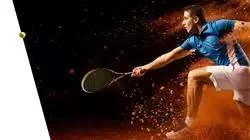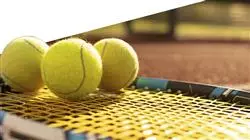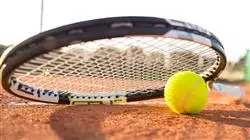University certificate
Scientific endorser

The world's largest faculty of sports science”
Introduction to the Program
The Postgraduate diploma in Applied Tennis Technology will provide you with the necessary knowledge to extract the maximum benefit from video analysis, in order to correct the mistakes made by the athlete and optimize their performance”

Technological advances have brought about an enormous revolution in the tennis scene over the last few decades. Their progressive incursion has made it a reality to measure the efficiency of the tennis player's stroke by means of sensors, as well as the analysis of technical and tactical movements through the video. These tools are excellent allies for the coach, since they enable the accurate analysis of the athlete's attributes and the design of more rigorous training, aimed at improving their faults with greater accuracy. Therefore, coaches whose vocation is to help elite tennis players achieve their competitive goals are required to use these innovations to improve their results.
This is why TECH has promoted the creation of this Postgraduate diploma, through which students will significantly increase and update their knowledge in the use of Applied Tennis Technology. During 450 intensive hours of teaching, students will identify the benefits offered by video analysis to adapt match strategies based on the game characteristics of each opponent. They will also analyze its utility to work on the improvement of the depth and volley technique of the tennis player or delve into the main biomechanical aspects that have a direct impact on the adequacy of their stroke.
All this, following a 100% online methodology, which will allow the sports professional to achieve effective learning with the development of their own study schedules. In addition, this Postgraduate diploma has been designed by leading tennis coaches with extensive experience in the preparation of players of different ages. Because of this, all the knowledge that they will assimilate will be completely applicable in their work life.
Through this program, you will identify the sensors present in some types of racquets to detect the quality of the tennis player's stroke and work in a sophisticated way to improve it”
This Postgraduate diploma in Applied Tennis Technology contains the most complete and up-to-date scientific program on the market. The most important features include:
- Practical case studies are presented by experts in tennis of elite
- The graphic, schematic, and practical contents with which they are created, provide scientific and practical information on the disciplines that are essential for professional practice
- Practical exercises where the self-assessment process can be carried out to improve learning
- Its special emphasis on innovative methodologies
- Theoretical lessons, questions to the expert, debate forums on controversial topics, and individual reflection assignments
- Content that is accessible from any fixed or portable device with an Internet connection
The 100% online format of this program will allow you to master the intricacies of Applied Tennis Technology at any time and from anywhere”
The program’s teaching staff includes professionals from the sector who contribute their work experience to this training program, as well as renowned specialists from leading societies and prestigious universities.
Its multimedia content, developed with the latest educational technology, will provide the professional with situated and contextual learning, i.e., a simulated environment that will provide an immersive education programmed to learn in real situations.
The design of this program focuses on Problem-Based Learning, by means of which the professional must try to solve the different professional practice situations that are presented throughout the academic course. For this purpose, the student will be assisted by an innovative interactive video system created by renowned experts.
Achieve an enjoyable and completely effective learning experience through teaching through formats such as video or interactive summary"

Over the course of this academic experience, you will analyze the biomechanical principles that allow you to optimize the tennis player's stroke and achieve perfection in the service and return”
Syllabus
The syllabus of this Postgraduate diploma has been designed to offer the student, through 3 very complete modules, the most advanced knowledge regarding Applied Tennis Technology. In addition, the didactic contents that will be available throughout this program are present in a large number of textual and multimedia formats that are differentiated from each other. Thanks to this and to its 100% online methodology, the sports professional will obtain a completely enjoyable and personalized learning experience.

Thanks to the avant-garde Relearning methodology of this program, you will obtain a tailored learning process without external teaching constraints”
Module 1. History and Standards
1.1. Historical Evolution of Tennis and its Regulations
1.1.1. What is Tennis, Where was it Invented and its Evolution Throughout History
1.1.2. Tennis Chronology
1.1.3. The Way of Counting, Origin and Evolution and Other Normative Aspects
1.1.4. Tennis Tournaments, History and Tennis at the Olympic Level
1.2. The Tennis Court, Different Surfaces and their Classification
1.2.1. Tennis Court Evolution
1.2.2. Track Measurements and General and Specific Aspects
1.2.3. The Different Existing Surfaces, General and Specific Concepts
1.2.4. Division of Tennis Courts According to Surface Speed
1.3. Racket, Ball and Permanent Fixtures
1.3.1. The Tennis Racket, the Ball and its Historical Chronology
1.3.2. Regulatory Aspects Regarding Tennis Rackets and Balls
1.3.3. What is a Permanent Fixture and its Regulatory Aspects
1.3.4. The Ball Touches the Line or the Ball Touches the Permanent Fixture
1.4. Service and Return
1.4.1. Server and Subtract or Selection
1.4.2. Side and Serve Selection
1.4.3. Side Changes, Regulations and Peculiarities
1.4.4. Service Failures. Let and Repetition of Serve
1.4.5. A Return is Good
1.5. Side Changes, Punctuation and their Alternative Systems
1.5.1. Track Side Changes and its Regulations
1.5.2. Scoring System in the Game, Set and Matches
1.5.3. Alternative Scoring Systems
1.5.4. A Player Loses the Point
1.6. Code of Conduct
1.6.1. What is the Code of Conduct and What is its Purpose?
1.6.2. Benefits of the Code of Conduct and its Evolution
1.6.3. General Aspects of the Code of Conduct
1.6.4. Specific Aspects of the Code of Conduct
1.7. Competition Systems and their Alternatives and Regulations
1.7.1. What Competition Systems Exist
1.7.2. Regulations of the Different Existing Competitions
1.7.3. Modern Types of Competition and their Benefits
1.7.4. Competition in Training Stages and its Regulations
1.8. Referees on the Court, Importance and their Function
1.8.1. Referee's Role on the Court
1.8.2. Player Instructions
1.8.3. Arbitration Systems. Hawk Eye and its Peculiarities
1.8.4. Principle of Continuous Play
1.8.5. Player Discomfort
1.8.6. Correction of Errors
1.9. Doubles Game and its Regulations
1.9.1. General Aspects of Doubles Play
1.9.2. Scoring in the Doubles Game and Existing Options
1.9.3. Service and Rest in Doubles Play
1.9.4. Doubles Competitions
1. 10. Professional Tennis Tournaments, Circuits and Regulations
1.10.1. Evolution of Professional Tournaments, Circuits and their Regulations up to the Present Time
1.10.2. Existing Tennis Tournaments and their Regulations
1.10.3. ATP and WTA Circuit and Aspects Regulated by Regulations
1.10.4. Different Prizes in Tennis Tournaments and Aspects Governed by the Regulations
Module 2. Biomechanics and Motion
2.1. What is Biomechanics and its Evolution
2.1.1. Definition and Introduction to Biomechanics
2.1.2. Evolution Concept of Biomechanics Throughout History
2.1.3. What is Biomechanics for and What are its Objectives
2.1.4. Benefits of Biomechanics and Main Components
2.1.5. Traditional Vision of Teaching Tennis Strokes and Modern Vision
2.2. The Correct Performance of the Technique and its Benefits
2.2.1. Definition of Optimal Technique
2.2.2. Components of the Technique
2.2.3. Benefits of the Optimal Technique
2.2.4. Execution of the Optimal Technique
2.3. Variability as a Fundamental Part of the Performance of the Strokes
2.3.1. Variability Concept
2.3.2. Mechanical Variability in Stroke Performance
2.3.3. Mechanical Variability in Stroke Development
2.3.4. Mechanical Variability in Tissue Loading
2.4. Principles of Biomechanics in Tennis. BIOMEC
2.4.1. Balance
2.4.2. Inertia
2.4.3. Opposition of Forces
2.4.4. Momentum
2.4.5. Elastic Energy
2.4.6. Coordination Chain
2.5. Coordination Chain
2.5.1. Definition
2.5.2. Coordination and Movement Chains
2.5.3. How to Generate Power in Strokes
2.5.4. Problems in the Coordination Chains
2.6. The Phases of the Stroke in Tennis
2.6.1. Preparation and Backward Movement of the Racket
2.6.2. Forward Movement of the Racket
2.6.3. Impact
2.6.4. Accompaniment and Termination
2.7. General Biomechanical Aspects of Groundstrokes
2.7.1. Biomechanics of the Forehand Stroke. Part I
2.7.2. Biomechanics of the Forehand Stroke. Part II
2.7.3. Biomechanics of the Two-handed Backhand Stroke
2.7.4. Biomechanics of the One-handed Backhand Stroke
2.8. General Biomechanical Aspects in Service and Return
2.8.1. Biomechanics of the Service in Tennis. Part I
2.8.2. Biomechanics of the Service in Tennis. Part II
2.8.3. Biomechanics of the Return in Tennis
2.8.4. Biomechanics of the Backhand in Tennis
2.9. General Biomechanical Aspects of Groundstrokes
2.9.1. Biomechanics of the Forehand Volley
2.9.2. Biomechanics of the Backhand Volley
2.9.3. Approach Biomechanics
2.9.4. Biomechanics of Backtacking
2.10. Movement, Displacements and Footwork
2.10.1. What are Displacements in Tennis
2.10.2. Phases of Movement in Tennis
2.10.3. Importance of Footwork
2.10.4. How to Work on Footwork in Tennis
Module 3. Tennis and Video Analysis Technology
3.1. The Evolution of Technology, General Considerations Applicable to Tennis
3.1.1. The Importance of Technology in Sports Today
3.1.2. The Evolution of Technology in Tennis Throughout History
3.1.3. Types of Technologies Applicable in Tennis
3.1.4. Technological Methodology
3.2. The Importance of Technology and Innovation in Tennis and its Benefits
3.2.1. Technology, its Applicability to Tennis and its Importance
3.2.2. Objectives of the Implementation of New Technologies in Tennis
3.2.3. Benefits of Using Technology in Tennis
3.2.4. R+D+I in the Tennis Industry
3.3. Technology on the Tennis Court
3.3.1. The Evolution of Tennis Court Throughout History
3.3.2. Current Tennis Courts and Their Technology
3.3.3. Tennis Court Advertising
3.3.4. Technology in Tennis Materials
3.4. Hawk Eye and Other Arbitration Systems
3.4.1. What is the Hawk Eye?
3.4.2. How is the Hawk Eye Used?
3.4.3. Benefits of the Use of the Hawk Eye in Competition
3.4.4. When Do I Have the Right to Use the Hawk Eye?
3.4.5. Other Arbitration Systems
3.5. The Tennis Racket, its Evolution and the Implementation of Technology in It
3.5.1. Existing Racket Types
3.5.2. Evolution of the Tennis Racket Throughout History
3.5.3. Tennis Racket Depending on the Player's Style
3.5.4. New Technologies in Tennis Rackets
3.6. Strings, Evolution and Types Depending on Playing Style
3.6.1. Importance of Strings for Tennis Players
3.6.2. The Evolution of Stringing Throughout History
3.6.3. Types of Strings and Classification
3.6.4. Tension and Types of Strings Depending on the Tennis Player's Playing Style
3.7. What is Video Analysis and its Benefits for Tennis Players?
3.7.1. Video Analysis Concept
3.7.2. Objectives of Video Analysis in Tennis Players
3.7.3. Benefits for Players and Coaches in the Use of Video Analysis
3.7.4. Video Analysis and Tactics
3.8. Clothing, the Tennis Ball and its Evolution and Implementation of Technology
3.8.1. Evolution of Tennis Apparel Throughout History
3.8.2. Types of Shoes Depending on the Tennis Court Surface
3.8.3. Evolution of the Tennis Ball Throughout History
3.8.4. Types of Tennis Ball and their Classification Depending on Speed
3.9. Practical Examples in the Use of Technology and Video Analysis in Technical Work
3.9.1. Analysis and Improvement of the Bottom Blows by Means of Video Analysis
3.9.2. Analysis and Service Improvement Through Video Analysis
3.9.3. Analysis and Improvement of Volleys Through Video Analysis
3.9.4. Other Technical Aspects Through Video Analysis
3.10. Practical Examples in the Use of Technology and Video Analysis in Tactical Work
3.10.1. Video Analysis and Ball Height Improvement. Exercises to Correct it
3.10.2. Video Analysis and Depth Enhancement. Exercises to Correct it
3.10.3. Video Analysis and Ball Directions. Exercises to Improve it
3.10.4. Video Analysis and Improvement of Service Areas. Exercises to Improve it

Enroll in this Postgraduate diploma and enjoy educational content available in a wide range of multimedia and textual formats that will allow you to optimize your learning”
Postgraduate Diploma in Applied Tennis Technology
Technology has completely changed the world of tennis, enabling the improvement of personalized training, aimed at extracting the maximum performance of the athlete on the court. Therefore, coaches must be aware of the technological advances experienced in this discipline in order to provide the best services to tennis players. Consequently, TECH has developed the Postgraduate Diploma in Applied Tennis Technology, a program that gives you the tools and skills necessary to keep up with the latest trends and developments in this field. All this, following a 100% online methodology that will allow you to study from anywhere and during 24 hours a day.
Expand your tennis-oriented technological skills with this program
Are you interested in specializing in the use of technological tools to improve tennis coaching? This Postgraduate Diploma in Applied Tennis Technology is designed specifically for you! Through it, you will be able to learn the keys to the use of video in training or identify the advanced sensors that rackets have to analyze the quality of the athlete's movements. In addition, you will study through cutting-edge teaching resources available in a wide range of multimedia formats that will completely enliven your learning.







